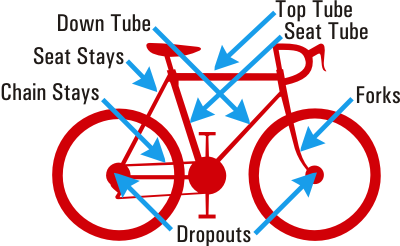Cycle Canada Blog
Preparing your Bike for Travel
by Bud Jorgensen
A Step-by-Step Primer
Mainly, it is the frame that you want to protect. Fixing a
frame is the most problematic repair if there is damage in transit.
These tips by Bud Jorgensen, founder of Tour du Canada and owner/operator of Cycle Canada . Reflecting
his personal views from more than 40 years of recreational riding.
Preparing your Bike for Travel.

The diagram gives you basic terminology on the features of a bike frame.
Rack Trunks, Handlebar Bags, Panniers and Fenders:
Usually the bags will need to be removed, although
a rack trunk may be able to sit in place. Pack bike bags in empty spaces around the bike. Be sure to
position any metal attachments so they do not scratch the bike frame, or cover the metal with tape. Fenders
will have to come off where a wheel is removed. Tape or zip-tie them to the wheels.
Cyclo-Computer:
Remove the handlebar mount assembly. Tape it to the frame so the wires are protected.
Remove the Pedals:
Note that the pedal on the right has right-hand threading and on the left it is left-hand
threading. Turn counter-clockwise to remove the pedal on the right and clockwise to remove the one on
the left. You may need a special pedal wrench for removal, although new pedals usually have an Allen
key fitting at the end of the pedal axle. Put the pedals in bags or wrap them with bubble wrap.
Gears and Tires:
Put the chain on the smallest ring on the front. Deflating the tires is a simple precaution
to ensure that they won't pop during a flight, although most cargo holds are pressurized.
Front Wheel:
Usually, you will have to remove the front wheel. The skewer that holds the front wheel
onto the bike should be removed. Be sure that both springs are back on the skewer axle and the bolt is put
back onto the end that is threaded. Put the skewer in a bag. Then place a spacer between the drop-outs
on the forks (see "Handy Stuff" on reverse of this sheet). Pack the wheel in a large garbage bag.
Rear Wheel:
It's best if the rear wheel can stay on the bike. If you must remove the rear wheel, place a
spacer between the drop-outs; remove the skewer and put it in a bag; and put the wheel in a large garbage
bag. If the wheel is removed, unscrew the bolt that holds the derailleur in place. Don't detach the chain
or disconnect the derailleur cable. Bag or wrap the derailleur and tape or zip-tie it to the frame.
Saddle:
Leave the saddle connected to the seat post. Remove from the frame or lower into the frame, if
necessary. If the seat post is moved, be sure to tighten the binder bolt so that it stays in place.
Handlebars:
Handlebars will at least need to be turned and they may need to be removed as well. If
removed, tape or zip-tie the bars to the forks. If the bars on your bike are held in place by a faceplate with
bolts, put the faceplate back on after the bars are removed or store the faceplate and bolts in a plastic bag.
Brakes:
Removing the handlebars may also mean removing the front brakes. Generally, it is best to leave
the brakes — both front and back — bolted to the frame. If they must be removed, be sure that they are
bagged or wrapped and taped or zip-tied securely to forks or stays.
Packing your Gear:
Before you close the bike box, put clothes in plastic bags and stuff those bags around
the frame of the bike and the wheels. Filling empty spaces in the box serves a dual purpose. It provides
extra protection for the bike and slims down the amount of stuff you need to pack elsewhere.
Last Steps:
Be sure to pack the parts bags and the tools you will need for re-assembly. If you have used
plastic zip-ties to hold things in place, include a pair of snips. Don't take any parts or tools in carry-on
luggage, because it probably won't pass airport security. Tape the flaps on the box with packing tape. Put
at least two labels on the box with contact information — your name and a phone number.
To download a printable sheet of this article visit: Shipping a Bike.
VeloHospitality's survey of shipping costs within Canada: Shipping a Bike
A Step-by-Step Primer
Mainly, it is the frame that you want to protect. Fixing a frame is the most problematic repair if there is damage in transit.
These tips by Bud Jorgensen, founder of Tour du Canada and owner/operator of Cycle Canada . Reflecting his personal views from more than 40 years of recreational riding.
Preparing your Bike for Travel.

The diagram gives you basic terminology on the features of a bike frame.
Rack Trunks, Handlebar Bags, Panniers and Fenders:
Usually the bags will need to be removed, although a rack trunk may be able to sit in place. Pack bike bags in empty spaces around the bike. Be sure to position any metal attachments so they do not scratch the bike frame, or cover the metal with tape. Fenders will have to come off where a wheel is removed. Tape or zip-tie them to the wheels.
Cyclo-Computer:
Remove the handlebar mount assembly. Tape it to the frame so the wires are protected.
Remove the Pedals:
Note that the pedal on the right has right-hand threading and on the left it is left-hand threading. Turn counter-clockwise to remove the pedal on the right and clockwise to remove the one on the left. You may need a special pedal wrench for removal, although new pedals usually have an Allen key fitting at the end of the pedal axle. Put the pedals in bags or wrap them with bubble wrap.
Gears and Tires:
Put the chain on the smallest ring on the front. Deflating the tires is a simple precaution to ensure that they won't pop during a flight, although most cargo holds are pressurized.
Front Wheel:
Usually, you will have to remove the front wheel. The skewer that holds the front wheel onto the bike should be removed. Be sure that both springs are back on the skewer axle and the bolt is put back onto the end that is threaded. Put the skewer in a bag. Then place a spacer between the drop-outs on the forks (see "Handy Stuff" on reverse of this sheet). Pack the wheel in a large garbage bag.
Rear Wheel:
It's best if the rear wheel can stay on the bike. If you must remove the rear wheel, place a spacer between the drop-outs; remove the skewer and put it in a bag; and put the wheel in a large garbage bag. If the wheel is removed, unscrew the bolt that holds the derailleur in place. Don't detach the chain or disconnect the derailleur cable. Bag or wrap the derailleur and tape or zip-tie it to the frame.
Saddle:
Leave the saddle connected to the seat post. Remove from the frame or lower into the frame, if necessary. If the seat post is moved, be sure to tighten the binder bolt so that it stays in place.
Handlebars:
Handlebars will at least need to be turned and they may need to be removed as well. If removed, tape or zip-tie the bars to the forks. If the bars on your bike are held in place by a faceplate with bolts, put the faceplate back on after the bars are removed or store the faceplate and bolts in a plastic bag.
Brakes:
Removing the handlebars may also mean removing the front brakes. Generally, it is best to leave the brakes — both front and back — bolted to the frame. If they must be removed, be sure that they are bagged or wrapped and taped or zip-tied securely to forks or stays.
Packing your Gear:
Before you close the bike box, put clothes in plastic bags and stuff those bags around the frame of the bike and the wheels. Filling empty spaces in the box serves a dual purpose. It provides extra protection for the bike and slims down the amount of stuff you need to pack elsewhere.
Last Steps:
Be sure to pack the parts bags and the tools you will need for re-assembly. If you have used plastic zip-ties to hold things in place, include a pair of snips. Don't take any parts or tools in carry-on luggage, because it probably won't pass airport security. Tape the flaps on the box with packing tape. Put at least two labels on the box with contact information — your name and a phone number.
To download a printable sheet of this article visit: Shipping a Bike.
VeloHospitality's survey of shipping costs within Canada: Shipping a Bike
Archives
Newsletters
Blogs
- Choosing a Road Bike
- Shipping a Bike (Introduction)
- Bike Fragility
- Shipping Costs VeloHospitality's survey of shipping costs within Canada

About Cycle Canada
Cycle Canada, The Veloforce Corporation is a Canadian owned and operated company. Cycle Canada has been offering affordable supported bicycle tours throughout Canada since 1988. Tours range from a 2 day, one week, two week to 10 weeks. Cyclists travel exclusively in Canada and in all 10 provinces with a range of challenge levels.
For a listing of all tours visit: Cycle Canada Tours
And to learn more about Cycle Canada and its activities visit: Cycle Canada
Wave the Flag
Shop at the Cycle Canada Store


